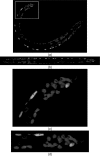Straightening Caenorhabditis elegans images
- PMID: 18025002
- PMCID: PMC2940239
- DOI: 10.1093/bioinformatics/btm569
Straightening Caenorhabditis elegans images
Abstract
Motivation: Caenorhabditis elegans, a roundworm found in soil, is a widely studied model organism with about 1000 cells in the adult. Producing high-resolution fluorescence images of C.elegans to reveal biological insights is becoming routine, motivating the development of advanced computational tools for analyzing the resulting image stacks. For example, worm bodies usually curve significantly in images. Thus one must 'straighten' the worms if they are to be compared under a canonical coordinate system.
Results: We develop a worm straightening algorithm (WSA) that restacks cutting planes orthogonal to a 'backbone' that models the anterior-posterior axis of the worm. We formulate the backbone as a parametric cubic spline defined by a series of control points. We develop two methods for automatically determining the locations of the control points. Our experimental methods show that our approaches effectively straighten both 2D and 3D worm images.
Figures





References
-
- Al-Kofahi KA, et al. Rapid automated three-dimensional tracing of neurons from confocalimage stacks. IEEE Trans. Inf. Technol. Biomed. 2002;6:171–187. - PubMed
-
- Blum H. Proceedings of the Symposium on Models for the Perception of Speech and Visual Form. Cambridge: MIT Press; 1964. A transformation for extracting new descriptions of shape.
-
- Corman TH, et al. Introduction to Algorithms. MIT Press, Cambridge, MA, USA; 2001.
-
- Fire A, et al. Potent and specific genetic interference by double-stranded RNA in Caenorhabditis elegans. Nature. 1998;391:806–811. - PubMed
-
- Haralick RM, Shapiro LG. Computer and Robot Vision. II. Addison-Wesley; 1992. pp. 316–317.

